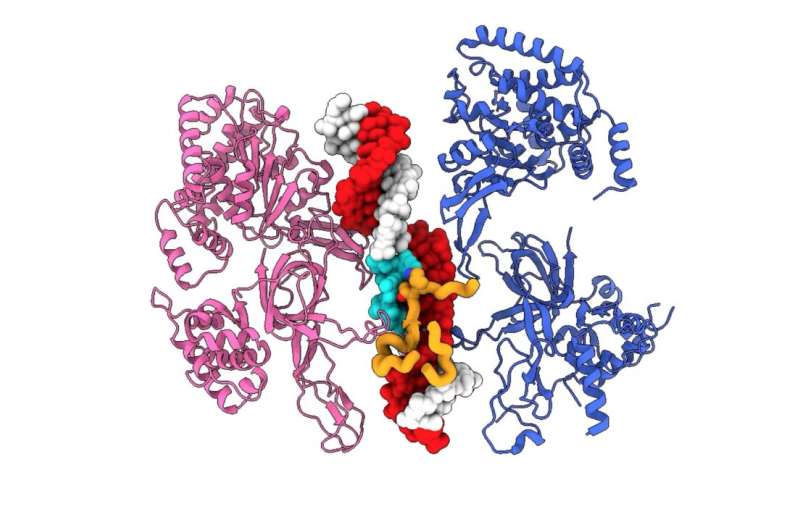The yeast replicative helicase captured as it opens the DNA double helix. Credit: The Francis Crick Institute
Researchers at the Francis Crick Institute have uncovered how the double helix structure of DNA is opened to allow DNA replication. The work could lead to further studies to better understand this process including how it can go wrong in diseases, such as cancer.
Since the discovery of the double helix structure of DNA nearly 70 years ago, scientists have worked to understand how the two strands of DNA are opened to access the genetic information they contain. This opening is required for essential processes including DNA repair, gene expression and replication of DNA for cell division.
In their study, published in Nature today (15 June), the scientists collaborated with the Crick's Chromosome Replication Laboratory to use a yeast model, to understand how the enzyme which opens DNA for replication works. The scientists used an advanced imaging method, called cryo-electron microscopy, to visualize the full process of the DNA double helix being untwisted and opened.
The team observed that, after embracing the DNA, two enzymes drift away from each other in a process that deforms the double helix, initiating the process of DNA opening.
Alessandro Costa, author and group leader of the Macromolecular Machines Laboratory at the Crick, says: "Over decades, scientists, including our collaborator John Diffley in at the Crick, have pieced together which enzymes are required to open DNA and initiate replication.
"We now looked at replication initiation under the microscope and discovered that the mechanism is completely different from the way the DNA double helix is opened to start other cellular processes, such as gene transcription and recombination. We hope that understanding this difference will allow us and other research groups to build a detailed picture that captures the complexities of life."
Jacob Lewis, author and Postdoctoral Training Fellow in the Macromolecular Machines Laboratory at the Crick, says: "Understanding the mechanism for the melting of the DNA double helix provides the basis to study how initiation of DNA replication is controlled. This has important implications for understanding the maintenance of chromosome integrity, a process which goes wrong in cancer."
The scientists will continue this work, to understand how the DNA replication machinery unzips the double helix after opening and how this is regulated to avoid accumulation of DNA damage.
More information: Jacob S. Lewis et al, Mechanism of replication origin melting nucleated by CMG helicase assembly, Nature (2022). DOI: 10.1038/s41586-022-04829-4
Journal information: Nature
Provided by The Francis Crick Institute
























